The macula is a small area at the center of the retina that allows us to see fine details such as central vision, activities such as reading and writing and appreciating colour vision.
Sometimes the delicate cells of the macula are damaged and stop functioning. The exact cause is not known although it tends to happen as people get older. This is called age-related macular degeneration (ARMD).
AMD is degeneration of the macula, which is the part of the retina responsible for the sharp, central vision needed to read or drive. Because the macula primarily is affected in AMD, central vision loss may occur
Macular degeneration is diagnosed as either dry (non-neovascular) or wet (neovascular). The dry form is more common than the wet form, with about 85 to 90 percent of AMD patients diagnosed with dry AMD. The wet form of the disease usually leads to more serious vision loss.
The dry type is caused by aging and thinning of the tissues of the macula. The wet type results from the formation of abnormal blood vessels under the macula which leak fluid or blood and blur the central vision.


Dry AMD is an early stage of the disease. Gradual central vision loss may occur with dry macular degeneration but usually is not nearly as severe as wet AMD symptoms. However, dry AMD through a period of years slowly can progress to late-stage geographic atrophy (GA) — gradual degradation of retinal cells with accumulation of cellular debris called drusen also can cause severe vision loss. Nutritional supplements containing antioxidants and multivitamins that contain lutein & zeaxanthin can reduce the risk of dry AMD progressing to sight-threatening wet AMD.
Currently, the best way to protect your eyes from developing early (dry) macular degeneration is to eat a healthy diet, exercise and wear sunglasses that protect your eyes from the sun’s harmful UV rays and high energy visible (HEV) radiation.
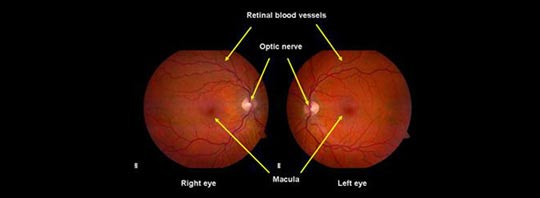
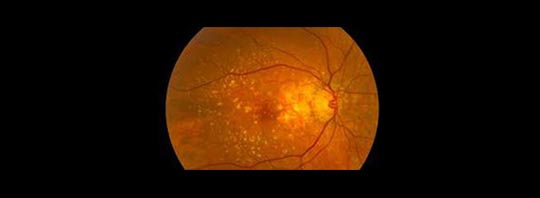
In about 10 percent of cases, dry AMD progresses to Wet macular degeneration. With wet macular degeneration, new blood vessels (choroid new vessels CNV) grow beneath the retina and leak blood and fluid. This leakage causes permanent damage to light-sensitive retinal cells, which die off and create blind spots in central vision. Wet macular degeneration falls into two categories:
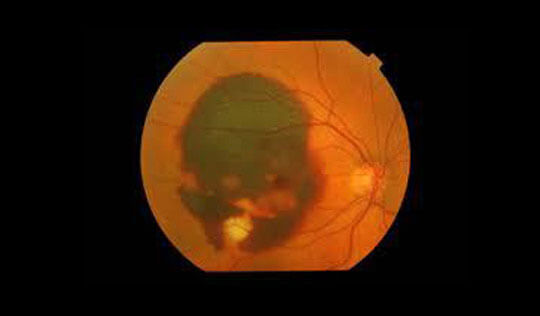 Occult form
Occult form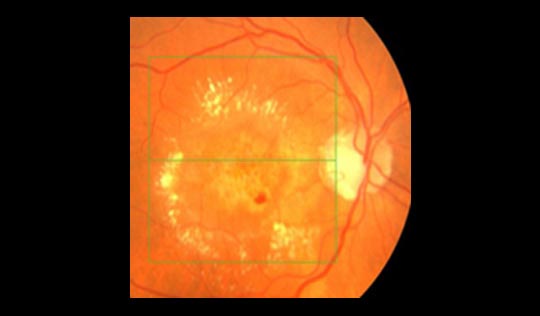 Classic form
Classic formOccult form.New blood vessel growth beneath the retina is not as pronounced, and leakage is less evident in the occult CNV form of wet macular degeneration, which typically produces less severe vision loss.
Classic form.When blood vessel growth and scarring have very clear, delineated outlines observed beneath the retina, this type of wet AMD is known as classic CNV, usually producing more severe vision loss.
This makes activities like reading, writing and recognizing small objects or faces very difficult.
An Amsler grid consists of crossed straight lines, with a reference dot in the center. Someone with macular degeneration may see some of the lines as wavy or blurred, with some missing / dark areas at the center.If your eye doctor detects some defect in your central vision, such as distortion or blurriness, he or she may order a fluorescein angiography to examine the retinal blood vessels surrounding the macula.
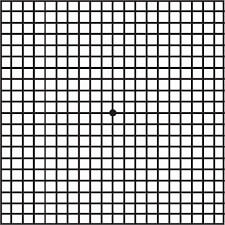 Amsler Grid : Normal Vision
Amsler Grid : Normal Vision Amsler Grid : Distorted Vew in ARMD
Amsler Grid : Distorted Vew in ARMDRISK FACTORS ASSOCIATED WITH ARMD : Smoking is high on the list of risk factors for macular degeneration. Other risk factors for macular degeneration include having a family member with AMD, Aging, high blood pressure, lighter eye color and obesity.
Viewing the macula with dilated pupils with 90D / 78D lens and slit-lamp.
Spectral OCT, FFA (Fundus Fluorescein Angiography) is done to find fluid / abnormal blood vessels under the macula. Indocyanine green angiography is done in certain cases.
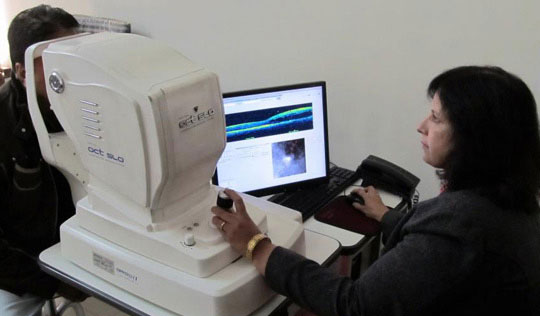
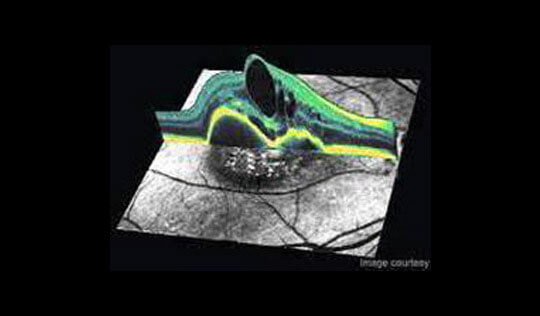
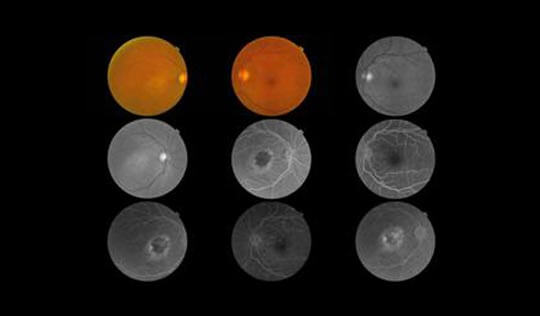 FFA IMAGES
FFA IMAGES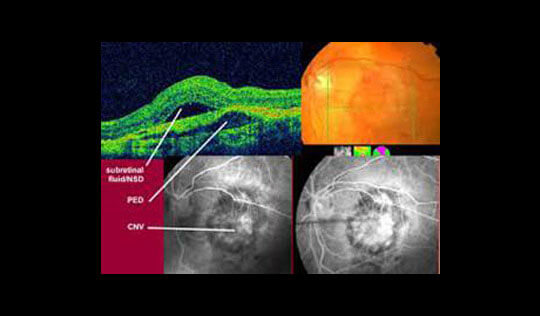 SPECTRAL OCT-SLO
SPECTRAL OCT-SLOFor Wet AMD treatment is aimed at stopping CNV, abnormal blood vessel growth with drugs called Anti-VEGF which include Lucentis, Accentrix, Macugen, Avastin etc. These are given as intravitreal injection into eyes of patients with Wet AMD with good results . Most patients will retain the vision they have and some will regain some of the lost vision after this treatment. The injections may need to be repeated on fixed intervals or as per response.
Lucentis, Accentrix eye injections & the colorectal cancer treatment drug Avastin work by inhibiting proteins called vascular endothelial growth factor (VEGF), which stimulate the growth of new blood vessels in the retina . Macugen uses a therapeutic molecule to attack VEGF in the eye.
Visudyne drug treatment (Photodynamic Therapy or PDT). Visudyne was the first drug therapy approved for treatment of the wet form of macular degeneration. It is only for those patients who have new blood vessel growth (neovascularization) under the retina in a well-defined, distinctive pattern known as "predominantly classic." About 40 to 60 percent of new wet AMD patients have this form of the disease .
TTT & Laser treatment. Laser photocoagulation is another macular degeneration treatment for wet AMD. The procedure uses laser light to destroy or seal off new blood vessels to prevent leakage. A major drawback of laser photocoagulation in such cases, however, is that it produces many small retinal scars, which cause blind spots in the patient's visual field. For this reason, the laser procedure is no longer widely used to treat AMD.
For wet AMD, treatments aimed at stopping abnormal blood vessel growth include drugs called AntiVEGF drugs Lucentis, Accentrix, Macugen and Avastin are given as intravitreal injection into Eye in patients with Wet AMD with good results by Vitreoretinal surgeon .
Many options are available at our hospital for patients who have advanced AMD damage or very poor vision due to various reasons. A Fresnel sheet magnifier is given free to patients who have both eyes intra-vitreal Lucentis / Accentrix injection along with complete ARMD tests at our hospital.
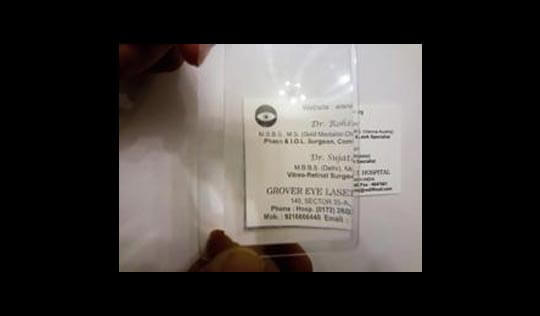
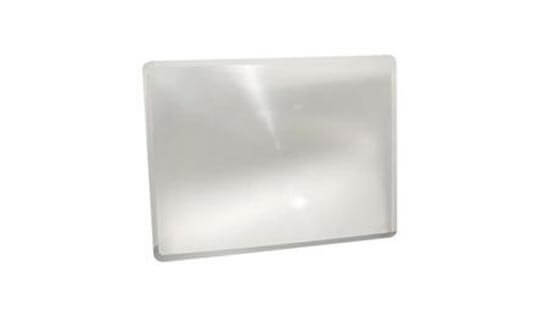
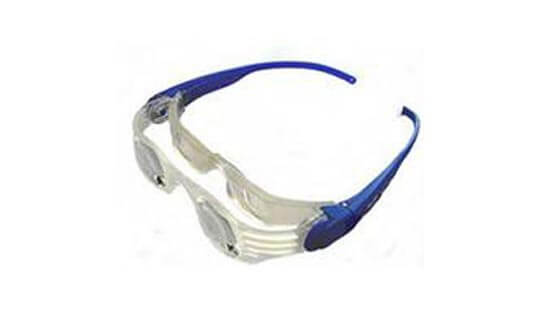
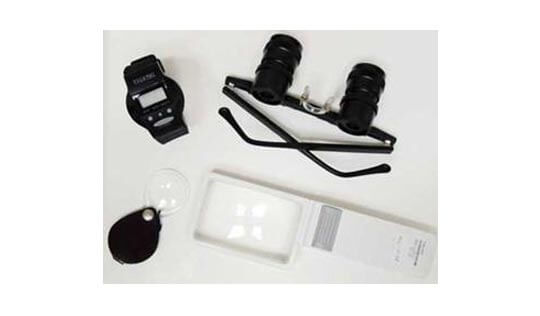

Regular monitoring of your central vision at home with an Amsler grid will help us detect progression in the early stages. Any abnormality or its progression must immediately be reported. You will be given an Amsler-Grid chart to moniter the same. Stop smoking totally. Good diet with fresh fruits & greens, Anti-Oxidant medicines are prescribed.
Macular degeneration usually affects people over age 65, which is why the term age-related macular degeneration (AMD) often is used to describe the condition. However, certain drugs can cause macular degeneration, and some cases are inherited, such as Stargardt’s Disease which can affect children and young adults.